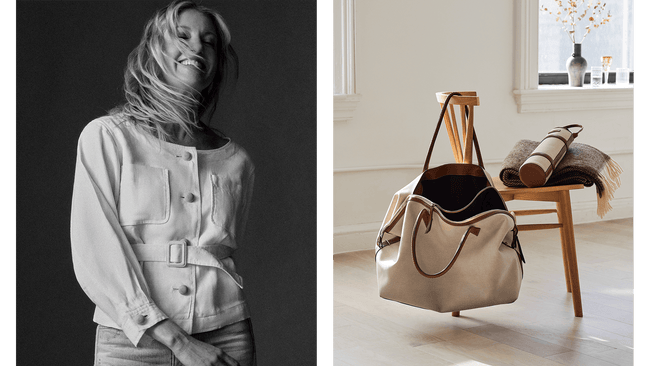In The Press: Melissa Morris x Goop
Extra! Extra!
15 November 2023

On the idea for the Perriand Weekend bag:
Whenever I start, I start because I’ve identified a journey that I don’t feel we’re currently serving with something in our collection. In this case, it was a weekender. Especially being in Europe, it’s an amazing thing—COVID aside—being able to be on the go all the time: Getting to go to an airport and in four hours, door to door, you can be in Copenhagen or somewhere totally different. I had a small wheelie bag at the time, and I just found that it wasn’t optimal for a few reasons.
One, it wasn’t easy to dart around—I wanted something I could carry. But then as well, the amount of times that you need your passport or your travel documents or your phone or whatever else, I felt like I needed something at my fingertips. So I wanted to create a weekender that you could carry, and I knew that meant it had to be really, really lightweight. Empty, it needs to be pretty weightless. But then when you put your things in, it needs to be something comfortable, otherwise you never would carry it.
I also was sensitive to when you carry a bag, how it feels, so the grip under the handle, and how it falls on your shoulder. I took a lot of care in terms of the type of rope we put underneath, inside the handle—it feels really soft. The width of the handle also was important to me. It can’t be too thick because then your hand doesn’t go around it properly, and it can’t be too thin because then it kind of cuts into your shoulder. And the ergonomics of the base of the bag: I developed a way to do this sort of hourglass shape for the base of all of the bags. You don’t have this straight hard line that hits into your hip, but rather it sort of wraps around you like a pillow. Then I also was looking into collapsibility. So depending on how much you pack, if things can expand and collapse elegantly.
And I also wanted it to have an easy way to access your essentials. I noticed that if you have a zipper closure on your bag, you end up never using it because you always need to grab your phone or something urgently, which then defeats the purpose. So I have a hidden pocket on the outside; it’s in the seam at the top of the bag, and it has two magnets that hold it together—you would never even know it’s there. You could easily put something very functional or utilitarian-looking like a patch pocket or an exterior pocket. Just aesthetically, I tend not to love how that looks. I want things to look a little bit more elegant and streamlined.
On finding inspiration in a surprising place:
I love boat design, and I think when you think about seamless utility or seamless functional design, no one does it better than boats. So you think about having these seamless pockets on the outside: It’s incredibly functional, but it’s still incredibly elegant. And what I love about boat design is the maximization of space. I spent a while studying it and just was really amazed at how cleverly you can utilize the walls of the boat and the space. And I sort of took that and applied that to the bag design. And so lining the walls of the entire bag are pockets. On one side you have for your laptop. On the other side, you can stick your toiletries case. The other side, your chargers, your glasses, your sunglasses. By utilizing the walls of the bag, it allows the whole center cavity to be for packing—instead of if you stack everything up from top to bottom and it gets much bulkier and much more disorganized.
On finding the right factory to work with:
It took about six months to find a factory that was producing at this level, but then also it was important to me that there were no subcontractors being used, so they were producing 100 percent of everything inside. And [finding a factory] that was also open to working with a new brand—a real risk for them. They spend a lot of time and money developing products and don’t know where the brand is going to go.
Producing 100 percent inside was really important to me for two reasons. One, I felt a real responsibility to my clients that if I tell you that this is going to last and be the best quality, I need to know everyone who’s stitching everything. And two, I felt a responsibility to know what sort of working conditions I’m supporting so I know what’s going on.